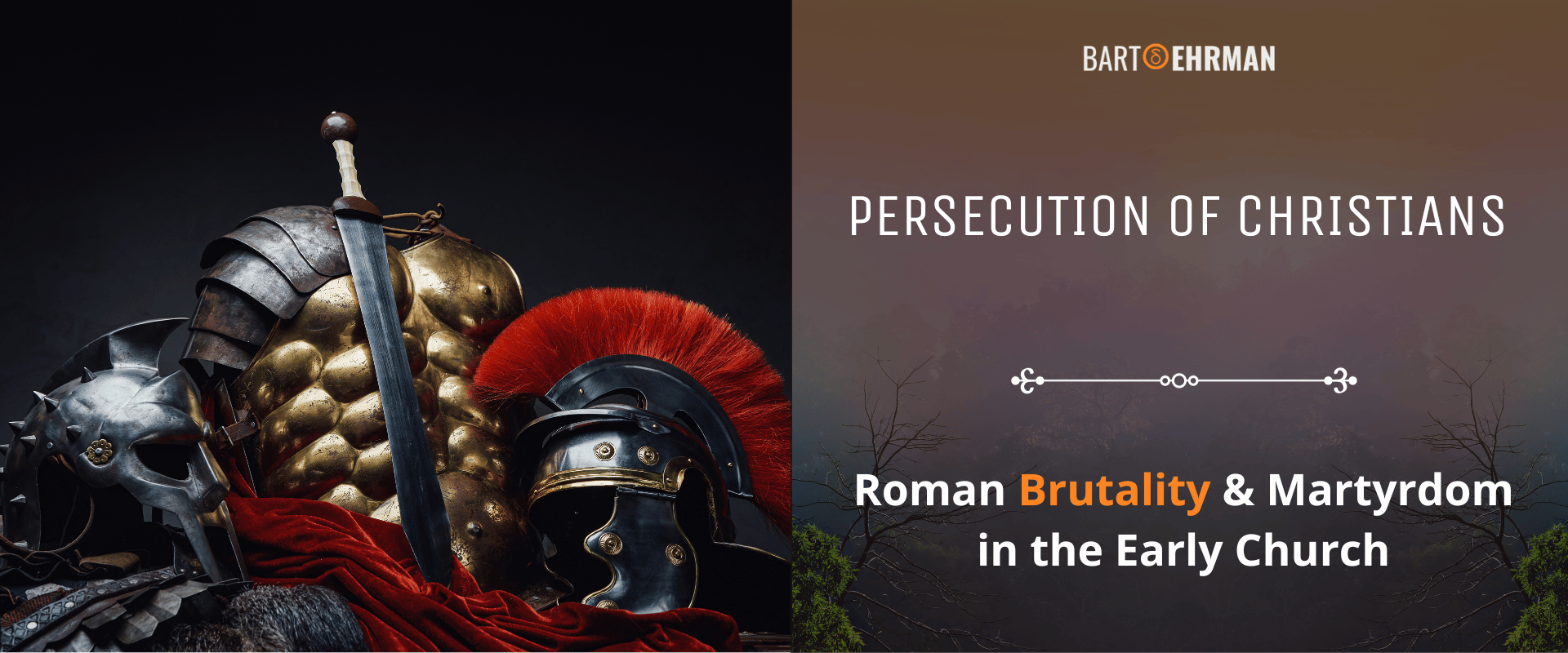Persecution of Christians: Roman Brutality & Martyrdom in the Early Church

Written by Marko Marina, Ph.D.
Author | Historian | BE Contributor
Verified! See our guidelines
Verified! See our editorial guidelines
Date written: October 30th, 2023
Disclaimer: The views and opinions expressed in this article belong to the author and do not necessarily match my own. - Dr. Bart D. Ehrman
The annals of antiquity bear witness to a complex tapestry of religious and political dynamics, often culminating in the persecution of religious minorities. Among these persecuted groups, early Christians in the Roman Empire occupied a prominent position.
In this historical exploration, we embark on a dispassionate journey into the past, seeking to analyze the factors, events, and motivations that led to the persecution of Christians in the Roman Empire.
Our inquiry is driven by a scholarly curiosity to understand why Romans persecuted Christians, the extent to which the early Church persecution was widespread, and the nature of the historical evidence that enables us to reconstruct these events.

Popular Myths About the Early Persecution of Christians
To commence our examination of the interplay between Romans and Christians, it's essential to underscore several prevailing misconceptions that continue to circulate today. While these myths may be widely embraced, they fail to align with the historical reality. The subsequent enumeration draws inspiration, in part, from an insightful analysis conducted by Dr. Candida Moss.
#1 During the first three centuries, Christians were everywhere hunted and killed for their faith
Christians were mostly left alone, just as other religions were. Despite common pictures of persecuted Christians, before the emperor Decius (249 C.E.), the Roman government never issued any state-wide persecution.
Speaking of the first 250 years of Christianity, Dr. Moss notes: “We have no reports of soldiers rounding up Christians, and the evidence that we do have suggests that Romans were strongly opposed to this kind of specific targeting. The climate was hostile, but there was no active persecution.”
#2 Roman catacombs were the only place where Christians felt safe and they provided excellent hiding spots from the dangerous Roman government
Arguably the most captivating myth surrounding Christian persecution relates to the notion of Christians clandestinely sheltering and establishing hidden enclaves within the Roman catacombs. In reality, the majority of Christians didn't resort to hiding, nor did they establish covert encampments beneath the earth.
Nevertheless, these catacombs stand as remarkable archaeological sites as they unveil a treasury of early Christian art. A visit to these subterranean labyrinths is a highly recommended experience for anyone traveling to Rome.
#3 Romans killed hundreds of thousands of Christians in the first three centuries of Christianity
It’s a myth that emerged on the backs of martyr ideology. Modern scholars are much more realistic with the numbers. Take, for instance, W. H. C. Frend’s relatively common conclusion that during Decius’ persecution, a couple of hundred Christians were killed. That’s far from the victimized picture of countless killed Christians that later authors helped create.
#4 Christians worshiped Jesus as God, and the Romans considered this a danger to the stability of the imperial cult
Indeed, the Romans held a deep reverence for certain emperors, with some (e.g. Augustus) even receiving divine honors during their lifetime. Additionally, a noteworthy study by Ittai Gradel has shed light on the extensive prevalence of the imperial cult, extending even to the Italian peninsula.
However, Romans didn’t mind that Christians worshiped Jesus. The problem wasn’t whom the Christians worshipped, but whom they refused to worship!
#5 During Roman persecution, most Christians stood their ground and died for their faith
This misconception often arises from an oversimplification of the historical narrative. As I demonstrated in an earlier article, later Christian writers, such as Eusebius, frequently downplayed or omitted instances of Christians who abandoned their faith.
It's essential to recognize that the pervasive societal pressures, even in the absence of explicit persecution, often influenced individuals to renounce the "new" religion.
Timeline of Persecution: From Nero (64 C.E.) to Diocletian (303 C.E.)
Christianity is a religion forged in fire. Jesus, as the central figure of a new religion, was killed at the hands of the Romans. The first Christian martyr was Stephen. According to Acts, Jewish religious authorities had Stephen arrested and killed on charges of blasphemy. His martyrdom represented the first recorded instance of a Christian willingly facing death for their faith.
But when did Romans start to persecute Christians?
Early persecution of the Christian Church commenced around 64 C.E. during the reign of Emperor Nero. In an attempt to deflect accusations that he had ignited the great fire in Rome, Nero singled out Christians as scapegoats.
Roman historian Tacitus (c. 115 C.E.) notes: “Consequently, to get rid of the report, Nero fastened the guilt and inflicted the most exquisite tortures on a class hated for their abominations, called Christians by the populace... Accordingly, an arrest was first made of all who pleaded guilty; then, upon their information, an immense multitude was convicted, not so much of the crime of firing the city, as of hatred against mankind (Annals 15.44).”
Why did Nero’s law target Christians? One theory suggests that his wife Poppaea Sabina was a sympathizer of Judaism. She, therefore, knew that the early Jewish followers of Jesus would make ideal scapegoats.
Did You Know?
Most historians today believe that Nero didn’t start the fire. Even Tacitus who is writing at the beginning of the 2nd century is aware of Nero’s innocence. However, most of my students still assume Nero’s guilt. How much the notion of Nero's involvement in the great fire in Rome is rooted in the collective memory of contemporary society is shown by the fact that the most famous disc-burning program bears Nero's name!
Later Christian tradition asserted that Petar and Paul were martyred during Nero’s persecution. While it is likely that they indeed died as martyrs, there exists no substantiated evidence to affirm Nero's direct involvement in their executions.
Nevertheless, Christian apologists have argued that 1 Peter refers to Nero’s persecution of Christians. If that is the case, the apostle Peter could be one of Nero’s victims.
However, as Dr. Ehrman noted in Peter, Paul, and Mary Magdalene, Nero’s persecution “extended only to the Christians living in Rome. It was not an empire-wide affair. The recipients of the letter of 1 Peter, however, live not in Rome but in the provinces of Asia Minor.”
Regardless of the exact place of Paul’s death, he is along Jesus probably the most important figure in the history of Christianity. But are they similar in their worldview? Would Paul and Jesus agree on everything? Uncover the profound theological distinctions between Paul and Jesus – two pivotal figures in Christian history. Delve into their teachings with Bart Ehrman's course, "Paul and Jesus: Bridging the Divide" today!
It’s essential to understand three basic features of Nero’s persecution:
FREE COURSE!
WHY I AM NOT A CHRISTIAN
Raw, honest, and enlightening. Bart's story of why he deconverted from the Christian faith.
Over 6,000 enrolled!
The next emperor involved in the persecution of Christians was Trajan (c. 112 C.E.). Based on exchanged letters between Trajan and Roman governor Pliny the Younger, we know that Christians were persecuted in the province of Bythinia (modern-day Turkey).
These letters provide an early window into the relationship between the Roman government and Christians. Pliny reveals that he devised the so-called “sacrifice test”. He set up the alters of the traditional (Roman) gods with statues.
He would then bring people accused of being Christians and demand that they worship Roman gods. If they complied, he would simply release them. However, if they refused, Pliny would instantly know that they were Christians. The fact that Pliny would excuse anyone who recanted illustrates that being a Christian wasn’t an irreversible crime. Refusing to stop being a follower of Jesus was the thing that led you to death.
Furthermore, this meant that Christians were in a unique legal position. Their crime was unlike any other. They were in a sense outlawed because of their name (Nomen Christianism). However, if they showed reverence to pagan gods, Christians would be released. No other crime in the Roman Empire (murder, stealing, revolt, etc.) was like that.
Additionally, Trajan instructed Pliny not to seek Christians. He only has to react based on the allegations from other members of society. In other words, Pliny depended heavily on the local people to inform him about Christians. The imperial government didn’t have neither the will nor the machinery to carry out a systematic persecution.
Persecution occurred sporadically from then onward. Some Christians in Lyon were killed under Marcus Aurelius (c. 177 C.E.). But these persecutions were also localized. It was not until Christianity became a sizable minority in the middle of the 3rd century that any emperor made an empire-wide attempt to eliminate religion.
In 249 C.E. Emperor Decius issued an edict that required all Roman citizens to perform a religious sacrifice to the Roman gods and obtain a certificate (libellus) proving their compliance.
Previous generations of scholars believed that Decius was targeting specifically Christians. However, James Rives showed that his edict should be interpreted within the broad context of a great political, economic, and social crisis that struck the entire empire in the 3rd century.
The new emperor was hoping to restore the Pax deorum or the right relationship between Rome and the gods. It was the only way he knew how to react to the general crisis that threatened the entire country.
Both Christians and Jews, therefore, accidentally became a target of the Roman state. But even this attempt lasted only a little more than two years. Decius died during a campaign against the Goths in the Balkans (251 C.E.). The persecutions re-occurred during the reign of Valerian (253.-260. C.E.). However, with the ascension of his son Gallienus persecutions stopped.
The most significant effort to wipe out Christianity came at the beginning of the 4th century with the emperor Diocletian. He issued four edicts targeting Christians, their properties, and books. The “Great Persecution” lasted several years (303.-311. C.E.) but failed at the marginalization of Christians. The failure was caused by several key issues:
In the year 311 C.E. the emperor Galerius issued the Edict of Serdica which granted Christianity the status of religio licita (legal religion) and ended the persecution.

Understanding the Causes of Persecution
Why did Romans persecute Christians? To understand the causes of persecution, it’s necessary to comprehend the meaning and purpose of Roman religion!
Romans were polytheists. They believed in many gods and goddesses who occupied every corner of the world. Regardless of their number, every divine being was important and the most important were the state gods (Jupiter, Mars, Venus, etc.).
Moreover, religion in the Roman Empire was present in every aspect of society: from the household and villages to cities and provinces. Romans believed that the proper worship of gods would bring peace and stability to the whole empire. While they were tolerant of other religious traditions, their toleration had limits.
Christianity had three key features that caused the opposition and persecution:
All these features combined caused opposition from pagan mobs. Opposition that sometimes turned into real persecution.
How were these persecutions carried on? Romans had to follow the law. They weren’t supposed to seek Christians out – not before the Decius’ edict and later the Great Persecution of Diocletian. Ideas of Roman soldiers who constantly knocked on the doors and dragged poor Christians off are pure fiction.
Cognitio extra ordinem, as the Latin phrase was, denotes the legal proceedings in which the governors could interrogate Christians. There are many instances of these trials from the records of the Acts of the Christian martyrs.
The earliest account is the Martyrdom of Polycarp. Polycarp was a bishop of Smyrna (modern-day Turkey) who was executed around 156 C.E. These trials show that Roman officials often wanted to avoid unnecessary bloodshed. They would even give their best to persuade Christians to offer sacrifices and ensure their freedom.
However, some Christians ignored all requests and pleas. In Polycarp’s case, even the arresting officials tried to persuade him to acknowledge the divinity of pagan gods. When brought into the arena before the Roman proconsul, the bishop was again urged to show respect toward pagan gods.
He was even threatened with torture, but he steadfastly refused to honor pagan gods. The sufferings that come with torture, as he stated, are pale in comparison with the eternal torments (hell) reserved for those who reject Christ.
After refusing several times to accept the request of the Roman proconsul, Polycarp was burned at the stake. The author of the account implies that before the bishop’s death, God worked miracles to validate Polycarp as a faithful witness to the Christian religion.
Summing up Conclusion: What are we Dealing With?
The persecution of Christians reveals two important outcomes that shaped the future of the Roman Empire:
The early Church persecution that began with Nero’s actions had unintended consequences. It initiated important developments within Christianity.
They had to adapt and find other ways of communicating their message. In doing that, Christians acquired the means of not only surviving but ultimately triumphing over the pagan religions of the Roman Empire. An outcome that Nero couldn’t even imagine.
FREE COURSE!
WHY I AM NOT A CHRISTIAN
Raw, honest, and enlightening. Bart's story of why he deconverted from the Christian faith.
Over 6,000 enrolled!
